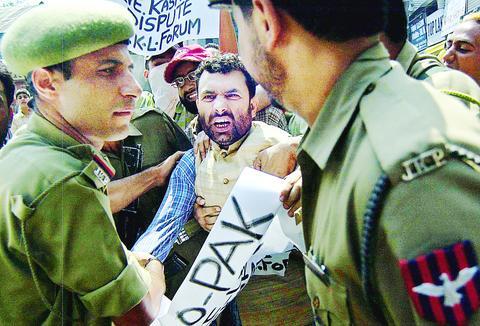India and Pakistan resolved to widen their peace dialogue yesterday as they discussed festering issues including their decades-old dispute over Kashmir.
India's Foreign Secretary Shyam Saran and his Pakistani counterpart Riaz Khokhar reviewed progress made in previous talks, paving the way for fresh dialogue to begin today. In a joint statement after the talks in New Delhi, the pair said talks had been "productive ... Several useful ideas and suggestions were made by both sides."

PHOTO: AP
India's External Affairs Minister Natwar Singh and Pakistani Foreign Minister Khursheed Kasuri were scheduled to meet in New Delhi today and tomorrow.
"The Foreign Secretaries discussed ways of taking the process forward," the statement said. "They would be reporting to the foreign ministers with the recommendation that the composite dialogue should be continued with a view to further deepening and broadening the engagement between the two sides."
At the heart of India-Pakistan tensions is Kashmir, where New Delhi has long accused Islamabad of arming Islamic militant groups who cross to the Indian side and carry out terrorist strikes.
The rebel groups have been fighting Indian security forces since 1989, seeking Muslim-majority Kashmir's independence from predominantly Hindu India or its merger with mostly Muslim Pakistan. More than 65,000 people have been killed in the conflict.
Islamabad denies New Delhi's charge that it helps the militant groups materially. Pakistan also says it is clamping down on rebels on its territory. But India says militants continue to cross from Pakistan-controlled Kashmir.
Sideshow
Meanwhile, as the diplomats met to push forward peace, their border guards play out a jingoistic ritual of confrontation for thousands of onlookers from both sides.
The display of hostility takes place every evening at a flag-lowering ceremony on both sides of the rivals' only border crossing.
Loudspeakers blare out patriotic Indian songs and soon the crowds at the Wagah border crossing begin to chant.
"Hail mother India!" is the cry from 8,000 Indians in a grandstand built beside the border gate, set amid green wheat fields.
"Long live Pakistan!" several thousand Pakistanis shout back from the other side of tall iron gates guarded by soldiers with assault rifles. "God is greatest."
The old rivals came close to a fourth war in 2002 but ties warmed last year, culminating in a summit between Pakistani President Pervez Musharraf and then Indian prime minister Atal Behari Vajpayee.
Crowds at the daily ceremony have swelled in the past couple of years to nearly 10,000 on the Indian side from a few hundred before, Indian border guards said.
Groups of Indian school girls dance in the stands and in the middle of the road as the music switches to a 1960s patriotic Bollywood song set to a modern tune.
The chanting reaches a crescendo as border guards dressed in ceremonial uniforms with tufted headgear begin a goose-step march to lower flags at the gate, stomping their boots with enough force to kick up dust on the asphalted road.
"The line between tourism and nationalism does not exist here," said a senior Indian officer.
"Military tensions are down and the soldiers are relaxed but it doesn't matter to the public. They get very excited."

A fire caused by a burst gas pipe yesterday spread to several homes and sent a fireball soaring into the sky outside Malaysia’s largest city, injuring more than 100 people. The towering inferno near a gas station in Putra Heights outside Kuala Lumpur was visible for kilometers and lasted for several hours. It happened during a public holiday as Muslims, who are the majority in Malaysia, celebrate the second day of Eid al-Fitr. National oil company Petronas said the fire started at one of its gas pipelines at 8:10am and the affected pipeline was later isolated. Disaster management officials said shutting the

US Vice President J.D. Vance on Friday accused Denmark of not having done enough to protect Greenland, when he visited the strategically placed and resource-rich Danish territory coveted by US President Donald Trump. Vance made his comment during a trip to the Pituffik Space Base in northwestern Greenland, a visit viewed by Copenhagen and Nuuk as a provocation. “Our message to Denmark is very simple: You have not done a good job by the people of Greenland,” Vance told a news conference. “You have under-invested in the people of Greenland, and you have under-invested in the security architecture of this

Japan unveiled a plan on Thursday to evacuate around 120,000 residents and tourists from its southern islets near Taiwan within six days in the event of an “emergency”. The plan was put together as “the security situation surrounding our nation grows severe” and with an “emergency” in mind, the government’s crisis management office said. Exactly what that emergency might be was left unspecified in the plan but it envisages the evacuation of around 120,000 people in five Japanese islets close to Taiwan. China claims Taiwan as part of its territory and has stepped up military pressure in recent years, including

UNREST: The authorities in Turkey arrested 13 Turkish journalists in five days, deported a BBC correspondent and on Thursday arrested a reporter from Sweden Waving flags and chanting slogans, many hundreds of thousands of anti-government demonstrators on Saturday rallied in Istanbul, Turkey, in defence of democracy after the arrest of Istanbul Mayor Ekrem Imamoglu which sparked Turkey’s worst street unrest in more than a decade. Under a cloudless blue sky, vast crowds gathered in Maltepe on the Asian side of Turkey’s biggest city on the eve of the Eid al-Fitr celebration which started yesterday, marking the end of Ramadan. Ozgur Ozel, chairman of the main opposition Republican People’s Party (CHP), which organized the rally, said there were 2.2 million people in the crowd, but